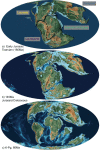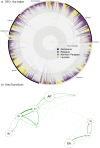Fossil-informed biogeographic analysis suggests Eurasian regionalization in crown Squamata during the early Jurassic
- PMID: 38708352
- PMCID: PMC11067913
- DOI: 10.7717/peerj.17277
Fossil-informed biogeographic analysis suggests Eurasian regionalization in crown Squamata during the early Jurassic
Abstract
Background: Squamata (lizards, snakes, and amphisbaenians) is a Triassic lineage with an extensive and complex biogeographic history, yet no large-scale study has reconstructed the ancestral range of early squamate lineages. The fossil record indicates a broadly Pangaean distribution by the end- Cretaceous, though many lineages (e.g., Paramacellodidae, Mosasauria, Polyglyphanodontia) subsequently went extinct. Thus, the origin and occupancy of extant radiations is unclear and may have been localized within Pangaea to specific plates, with potential regionalization to distinct Laurasian and Gondwanan landmasses during the Mesozoic in some groups.
Methods: We used recent tectonic models to code extant and fossil squamate distributions occurring on nine discrete plates for 9,755 species, with Jurassic and Cretaceous fossil constraints from three extinct lineages. We modeled ancestral ranges for crown Squamata from an extant-only molecular phylogeny using a suite of biogeographic models accommodating different evolutionary processes and fossil-based node constraints from known Jurassic and Cretaceous localities. We hypothesized that the best-fit models would not support a full Pangaean distribution (i.e., including all areas) for the origin of crown Squamata, but would instead show regionalization to specific areas within the fragmenting supercontinent, likely in the Northern Hemisphere where most early squamate fossils have been found.
Results: Incorporating fossil data reconstructs a localized origin within Pangaea, with early regionalization of extant lineages to Eurasia and Laurasia, while Gondwanan regionalization did not occur until the middle Cretaceous for Alethinophidia, Scolecophidia, and some crown Gekkotan lineages. While the Mesozoic history of extant squamate biogeography can be summarized as a Eurasian origin with dispersal out of Laurasia into Gondwana, their Cenozoic history is complex with multiple events (including secondary and tertiary recolonizations) in several directions. As noted by previous authors, squamates have likely utilized over-land range expansion, land-bridge colonization, and trans-oceanic dispersal. Tropical Gondwana and Eurasia hold more ancient lineages than the Holarctic (Rhineuridae being a major exception), and some asymmetries in colonization (e.g., to North America from Eurasia during the Cenozoic through Beringia) deserve additional study. Future studies that incorporate fossil branches, rather than as node constraints, into the reconstruction can be used to explore this history further.
Keywords: Biogeography; DEC; Fossils; Gondwana; Jurassic; Laurasia; Lizards; Snakes; Squamata.
©2024 Wilenzik et al.
Conflict of interest statement
The authors declare there are no competing interests.
Figures




Similar articles
-
Integration of molecules and new fossils supports a Triassic origin for Lepidosauria (lizards, snakes, and tuatara).BMC Evol Biol. 2013 Sep 25;13:208. doi: 10.1186/1471-2148-13-208. BMC Evol Biol. 2013. PMID: 24063680 Free PMC article.
-
At the feet of the dinosaurs: the early history and radiation of lizards.Biol Rev Camb Philos Soc. 2003 Nov;78(4):513-51. doi: 10.1017/s1464793103006134. Biol Rev Camb Philos Soc. 2003. PMID: 14700390 Review.
-
A toothed turtle from the Late Jurassic of China and the global biogeographic history of turtles.BMC Evol Biol. 2016 Oct 28;16(1):236. doi: 10.1186/s12862-016-0762-5. BMC Evol Biol. 2016. PMID: 27793089 Free PMC article.
-
The origin of snakes: revealing the ecology, behavior, and evolutionary history of early snakes using genomics, phenomics, and the fossil record.BMC Evol Biol. 2015 May 20;15:87. doi: 10.1186/s12862-015-0358-5. BMC Evol Biol. 2015. PMID: 25989795 Free PMC article.
-
An overview of the South American fossil squamates.Anat Rec (Hoboken). 2014 Mar;297(3):349-68. doi: 10.1002/ar.22858. Epub 2014 Jan 31. Anat Rec (Hoboken). 2014. PMID: 24482358 Review.
References
-
- Adalsteinsson SA, Branch WR, Trape S, Vitt LJ, Hedges SB. Molecular phylogeny, classification, and biogeography of snakes of the Family Leptotyphlopidae (Reptilia, Squamata) Zootaxa. 2009;2244:1–50.
-
- Alfaro ME, Karns DR, Voris HK, Brock CD, Stuart BL. Phylogeny, evolutionary history, and biogeography of Oriental–Australian rear-fanged water snakes (Colubroidea: Homalopsidae) inferred from mitochondrial and nuclear DNA sequences. Molecular Phylogenetics and Evolution. 2008;46:576–593. doi: 10.1016/j.ympev.2007.10.024. - DOI - PubMed
-
- Arnold EN, Arribas O, Carranza S. Systematics of the Palaearctic and Oriental lizard tribe Lacertini (Squamata: Lacertidae: Lacertinae), with descriptions of eight new genera. Zootaxa. 2007;1430:1–86.
-
- Barley AJ, Datta-Roy A, Karanth KP, Brown RM. Sun skink diversification across the Indian–Southeast Asian biogeographical interface. Journal of Biogeography. 2015;42:292–304. doi: 10.1111/jbi.12397. - DOI
Publication types
MeSH terms
LinkOut - more resources
Full Text Sources
Research Materials

